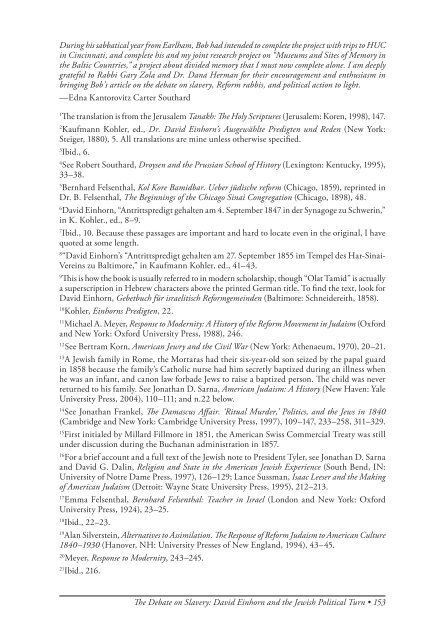American Jewish Archives Journal, Volume 64, Numbers 1 & 2
American Jewish Archives Journal, Volume 64, Numbers 1 & 2
American Jewish Archives Journal, Volume 64, Numbers 1 & 2
Create successful ePaper yourself
Turn your PDF publications into a flip-book with our unique Google optimized e-Paper software.
During his sabbatical year from Earlham, Bob had intended to complete the project with trips to HUC<br />
in Cincinnati, and complete his and my joint research project on “Museums and Sites of Memory in<br />
the Baltic Countries,” a project about divided memory that I must now complete alone. I am deeply<br />
grateful to Rabbi Gary Zola and Dr. Dana Herman for their encouragement and enthusiasm in<br />
bringing Bob’s article on the debate on slavery, Reform rabbis, and political action to light.<br />
—Edna Kantorovitz Carter Southard<br />
1The translation is from the Jerusalem Tanakh: The Holy Scriptures (Jerusalem: Koren, 1998), 147.<br />
2Kaufmann Kohler, ed., Dr. David Einhorn’s Ausgewählte Predigten und Reden (New York:<br />
Steiger, 1880), 5. All translations are mine unless otherwise specified.<br />
3Ibid., 6.<br />
4See Robert Southard, Droysen and the Prussian School of History (Lexington: Kentucky, 1995),<br />
33–38.<br />
5Bernhard Felsenthal, Kol Kore Bamidbar. Ueber jüdische reform (Chicago, 1859), reprinted in<br />
Dr. B. Felsenthal, The Beginnings of the Chicago Sinai Congregation (Chicago, 1898), 48.<br />
6David Einhorn, “Antrittspredigt gehalten am 4. September 1847 in der Synagoge zu Schwerin,”<br />
in K. Kohler., ed., 8–9.<br />
7Ibid., 10. Because these passages are important and hard to locate even in the original, I have<br />
quoted at some length.<br />
8 “David Einhorn’s “Antrittspredigt gehalten am 27. September 1855 im Tempel des Har-Sinai-<br />
Vereins zu Baltimore,” in Kaufmann Kohler, ed., 41–43.<br />
9This is how the book is usually referred to in modern scholarship, though “Olat Tamid” is actually<br />
a superscription in Hebrew characters above the printed German title. To find the text, look for<br />
David Einhorn, Gebetbuch für israelitisch Reformgemeinden (Baltimore: Schneidereith, 1858).<br />
10Kohler, Einhorns Predigten, 22.<br />
11Michael A. Meyer, Response to Modernity: A History of the Reform Movement in Judaism (Oxford<br />
and New York: Oxford University Press, 1988), 246.<br />
12See Bertram Korn, <strong>American</strong> Jewry and the Civil War (New York: Athenaeum, 1970), 20–21.<br />
13A <strong>Jewish</strong> family in Rome, the Mortaras had their six-year-old son seized by the papal guard<br />
in 1858 because the family’s Catholic nurse had him secretly baptized during an illness when<br />
he was an infant, and canon law forbade Jews to raise a baptized person. The child was never<br />
returned to his family. See Jonathan D. Sarna, <strong>American</strong> Judaism: A History (New Haven: Yale<br />
University Press, 2004), 110–111; and n.22 below.<br />
14See Jonathan Frankel, The Damascus Affair. ‘Ritual Murder,’ Politics, and the Jews in 1840<br />
(Cambridge and New York: Cambridge University Press, 1997), 109–147, 233–258, 311–329.<br />
15First initialed by Millard Fillmore in 1851, the <strong>American</strong> Swiss Commercial Treaty was still<br />
under discussion during the Buchanan administration in 1857.<br />
16For a brief account and a full text of the <strong>Jewish</strong> note to President Tyler, see Jonathan D. Sarna<br />
and David G. Dalin, Religion and State in the <strong>American</strong> <strong>Jewish</strong> Experience (South Bend, IN:<br />
University of Notre Dame Press, 1997), 126–129; Lance Sussman, Isaac Leeser and the Making<br />
of <strong>American</strong> Judaism (Detroit: Wayne State University Press, 1995), 212–213.<br />
17Emma Felsenthal, Bernhard Felsenthal: Teacher in Israel (London and New York: Oxford<br />
University Press, 1924), 23–25.<br />
18Ibid., 22–23.<br />
19Alan Silverstein, Alternatives to Assimilation. The Response of Reform Judaism to <strong>American</strong> Culture<br />
1840–1930 (Hanover, NH: University Presses of New England, 1994), 43–45.<br />
20Meyer, Response to Modernity, 243–245.<br />
21 Ibid., 216.<br />
The Debate on Slavery: David Einhorn and the <strong>Jewish</strong> Political Turn • 153
















